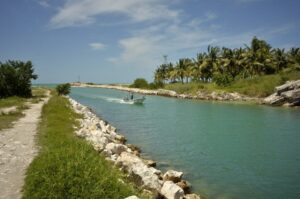How to Stop Erosion on Riverbanks
When your home, business, or land is threatened, you need to stop erosion on river banks fast. TrapBag provides an affordable and effective way to slow erosion.
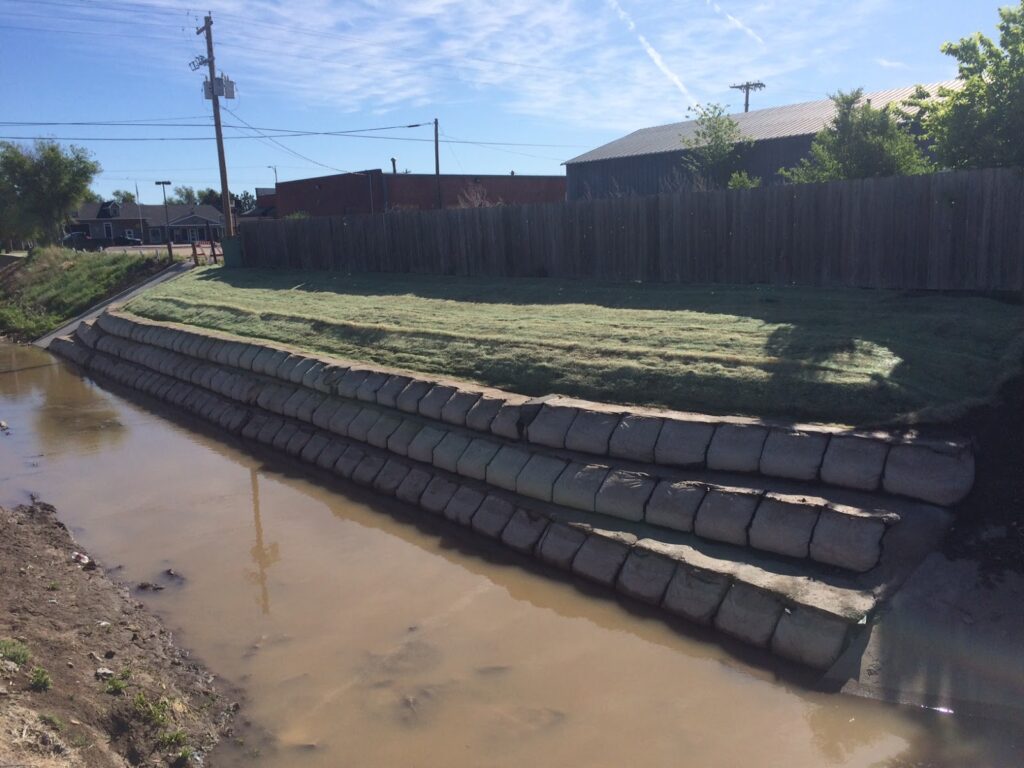
Riverbank erosion can be both dangerous and expensive for landowners. It can eat away at property, ruin the visual appearance of a river, and even change its course. Erosion can also create an unstable bank that vehicles such as tractors and lawnmowers can easily get stuck in.
What Causes Riverbank Erosion?
By preventing erosion on river banks, property owners can ensure that the area remains aesthetically appealing and doesn’t threaten the structural integrity of neighboring structures. A certain amount of riverbank erosion will occur naturally. The river water will break away small pieces of the bank and deposit them further downstream. This is what causes the shapes of rivers to slowly change over the course of decades.
But the process can be greatly sped up by a number of causes. One of the most common is severe flooding. Floodwaters can increase the speed and force of the flowing river, causing large chunks of the banks to break away. Other factors can include debris that falls into the river and redirects the flow of the water. Changes made to the river upstream can cause similar shifts in the current that can lead to riverbank erosion.
The banks can also be weakened by water from sources outside the river. For instance, a leak in a nearby water source, such as a pipe or water tower, can saturate the soil and cause the banks to weaken and collapse. Bank erosion can have a severe effect on the nearby area. If there are structures such as houses alongside the banks of the river, erosion can weaken their structural integrity. If the erosion progresses too far, the homeowner may have to abandon or relocate the home.
Riverbank erosion can also alter the shape of a river and change the speed at which it flows. This can trigger further changes as the faster currents cause more erosion and changes downstream.
Find a better form of erosion prevention here.
Prevent Riverbank Erosion
An effective and environmentally friendly method of riverbank erosion protection is to ensure that your banks have healthy vegetation. The roots of plants can help the banks maintain their structure and provide a barrier against erosion. The plants not only protect the soil against river water but also prevent erosion from rainfall as well.
The exact type of plant that should be used to prevent erosion along the banks of your river will depend on where you live, but ferns and grasses are typically a great choice. A rip rap is a barrier made of rocks and stones that protects the banks of the river from erosion. Rip raps can be effective in areas with heavy water flow, but they have several limitations.
Not only does rip rap clash with the natural look of the environment, but it also prevents wildlife from using the shoreline as easily. Riverbanks provide a space for birds to eat, mammals to make their homes, and dragonflies to spawn. Furthermore, rip rap can only be used on gradual slopes, since the rocks can slide down the banks if they are too steep, and they are susceptible to sediment buildup.
Building a Rip Rap Barrier
Rip raps should be built with angular rocks that are not going to roll down the slope and that aren’t susceptible to breaking from temperature changes. Igneous rocks such as granite are a good bet for building a rip rap, while materials such as crushed concrete should be avoided.
Placing fabric underneath the rocks will prevent soil from passing between them. In areas with particularly heavy currents, wire frames or fences can be used to prevent the rocks from being washed away. TrapBags are a great solution to stop erosion on river banks due to their durability, affordability, and flexibility. They work similarly to sandbags, but they are much stronger and more durable.
TrapBags can be deployed by a small team of laborers using heavy equipment within just a few hours. They can be moved and placed to match the curvature of the river and stacked to protect particularly vulnerable areas.
TrapBag as an Erosion Control Barrier
When weather forecasts predict severe flooding, TrapBags can be filled with dirt, gravel, or other natural materials to create a temporary barrier to protect vulnerable areas of your river banks from erosion. If erosion is a chronic issue in your river, TrapBags can be filled with concrete for a more permanent solution. TrapBags are far more efficient than sandbags, and have been used by individuals and government agencies to stop flooding and erosion from severe storms and hurricanes. They have been trusted to protect vital infrastructure and have prevented homes and businesses from being lost to erosion.
The speed at which TrapBags can be deployed makes them an ideal choice for responding quickly to emergency erosion situations. That’s why families in Florida turned to TrapBag to protect their homes and business from being destroyed by beach erosion in the aftermath of Hurricane Ian.
Order TrapBag Today
Looking to stop erosion on river banks on your property? Contact our friendly staff, and we can show you how TrapBag can create a strong solution for temporary or permanent erosion issues. We are happy to answer your questions and help you find out the right solution for your situation.
For immediate assistance, please call (239) 674-6611.
We are available 24/7. Water erosion along creek banks, river banks, or lake shorelines can cause damage to properties as well as the environment. When it comes to riverbank stabilization, there are many different methods available. Many methods involve using synthetic materials, but there are also natural options. Options that involve natural and biodegradable materials can enhance the appearance of a riverbank as well as benefit the ecosystem and wildlife.
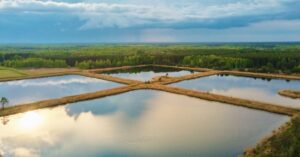
How to Protect Against Riverbank & Shoreline Erosion
Some bank protection techniques include the use of rip rap (hard armoring), planting vegetation, and using geotextile bags like TrapBag. Often, a combination of methods is the best solution.
Riverbank erosion can be prevented by avoiding harmful actions that lead to erosion. Some of these include:
- Removing vegetation
- Improper land use
- River redirection
Installing Natural Vegetation
The first method to stop riverbank erosion is natural vegetation. Natural vegetation has a massive impact on a riverbank. The plants form deep root systems which help to hold soil in place and protect it from being washed away. Plants can also absorb the shock of heavy rainfall. When using this method, make sure to use plants and trees native to the area. Some plants have more expansive (and therefore, helpful when it comes to erosion) roots systems than others.
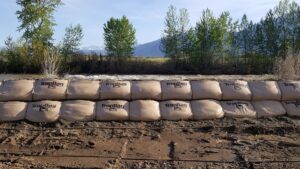
“The root system helps hold the soil together and increases the overall bank stability by its binding network structure, i.e., the ability of roots to hold soil particles together. Second, the exposed vegetation (stalks, stems, branches, and foliage) can increase the resistance to flow and reduce the local flow velocities, causing the flow to dissipate energy against the deforming plant rather than the soil. Third, the vegetation acts as a buffer against the abrasive effect of transported materials. Fourth, close-growing vegetation can induce sediment deposition by causing zones of slow velocity and low shear stress near the bank, allowing coarse sediments to deposit. Vegetation is also often less expensive than most structural methods; it improves the conditions for fisheries and wildlife, improves water quality, and can protect cultural/archeological resources.” — US Army Corps of Engineers
Bioengineering can be dependent on weather conditions and local wildlife.
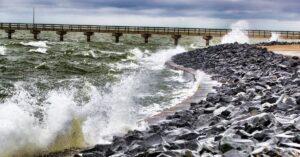
Riprap
Another method is riprap or hard armoring. Hard armoring involves the layering of rocks along the bank in order to protect it from water erosion. This, however, leads to problems. Riprap causes the speed of the current to increase because it reduces friction points. It also causes the deflected water to hit other exposed areas of the riverbank and worsen erosion there. Essentially, installing riprap in one area of a river or stream will necessitate its installation along the entire bank or shoreline.

It also negatively impacts the ecosystem.
“Another aspect of riprap is its considerable effect on wildlife, specifically fish that live in and utilize streams and rivers where eroding banks have undergone armoring. While erosion can cause potential problems for fish, especially in high-silt locations, the installation of riprap leads to other, more significant, issues. When riprap is the primary or only form of riverbank stabilization measure, the end result is typically a uniform, smooth channel, with no complexity.” — FEMA.gov
Riprap can also be costly to implement.
Geotextile Bags
The best way to protect a riverbank from erosion is using geotextile bags, like the TrapBag barrier system, which can stabilize the riverbank for temporary or permanent purposes.
Using natural materials to protect riverbanks
Does planting vegetation work?
Planting vegetation does typically work to help prevent streambank erosion. Sometimes weather conditions, wildlife, or the severity of the erosion can require the use of a combination of methods.
Do hard armoring or rip rap rock work for river banks?
“Riprap, or hard armoring, is the traditional response to controlling and minimizing erosion along shorelines or riverbanks. As demonstrated by past multiple disasters in Washington State, the U.S. Department of Homeland Security’s Federal Emergency Management Agency (FEMA) has provided funding assistance for the repair to these riprap facilities.*1 The very nature of having to repair these facilities counters the popular engineering belief that riprap is the best solution for mitigating stream bank erosion.“ — FEMA.gov
In the past, riprap has not only failed, but led to worsened conditions and environmental damage. When compared with the use of geotextile bags like TrapBag, riprap is more expensive and less effective.
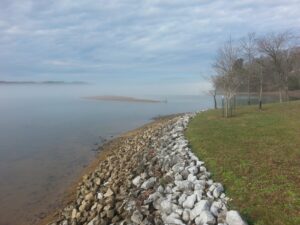
Granite boulders in the New Bedford Fairhaven hurricane barrier provide shelter for a variety of animals
Using TrapBag geotextile erosion control bags for riverbank erosion
The TrapBag® barrier system can be applied to stabilize a riverbank for temporary, semi-permanent or even permanent purposes when filled with concrete. Since the TrapBags® are stackable, the height of the riverbank is not a factor — this is key for tall riverbanks where rip rap/hard armoring is not an option.
The installation of a TrapBag® barrier system is much less costly and time consuming compared to other methods. Another benefit of using TrapBags® is that you can cover them with vegetation which not only creates a more natural look but it increases the stability of the riverbank.
TrapBag® is a series of pentagon-shaped bags that are sloped on one side, vertical on the opposite side and open at the top for filling. Each of the cells are connected side by side like an accordion, each cell has a common wall with the next cell, and are collapsed during storage and deployment. The cells are made of high-strength textile. Each of the cells are self-contained yet rely on the next cell for added strength. If one of the cells is compromised, it will not affect the rest of the barrier, which will remain standing strong.
TrapBag® uses 40% less fill material than a stacked sandbag wall, but more importantly a single 100 foot section of 4ft high TrapBag® replaces approximately 8,000 sandbags making TrapBag® Barriers an excellent alternative to small and large sandbags. TrapBag® Barriers can be filled with sand, washed gravel, or concrete. Avoid filling with silt, clay, or rocks greater than 2 inches across.
Order TrapBag Before the Next Big Storm
TrapBag® is available as an effective flood barrier system for riverbanks and other inland waterways. Request a quote today to get effective barriers when your community needs them most.
Meet the author
Get the Dirt Before the Flood Hits
Stay ahead of flooding, erosion, and disaster response challenges. The Dirt, TrapBag’s monthly newsletter, delivers field-tested tips, real-world case studies, and the latest in barrier technology straight to your inbox.

